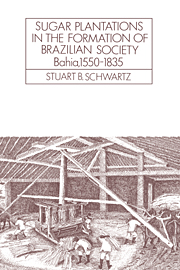Book contents
- Frontmatter
- Contents
- List of figures, maps, and tables
- Preface
- Abbreviations and special terms
- Weights and measures
- Dedication
- Part I Formations, 1500–1600
- 1 The sugar plantation: from the Old World to the New
- 2 A wasted generation: commercial agriculture and Indian laborers
- 3 First slavery: from Indian to African
- Part II The Bahian engenhos and their world
- Part III Sugar society
- Part IV Reorientation and persistence, 1750–1835
- Appendixes
- Notes
- Glossary
- Sources and selected bibliography
- Sources of figures
- Index
- CAMBRIDGE LATIN AMERICAN STUDIES IN PRINT
1 - The sugar plantation: from the Old World to the New
Published online by Cambridge University Press: 05 May 2010
- Frontmatter
- Contents
- List of figures, maps, and tables
- Preface
- Abbreviations and special terms
- Weights and measures
- Dedication
- Part I Formations, 1500–1600
- 1 The sugar plantation: from the Old World to the New
- 2 A wasted generation: commercial agriculture and Indian laborers
- 3 First slavery: from Indian to African
- Part II The Bahian engenhos and their world
- Part III Sugar society
- Part IV Reorientation and persistence, 1750–1835
- Appendixes
- Notes
- Glossary
- Sources and selected bibliography
- Sources of figures
- Index
- CAMBRIDGE LATIN AMERICAN STUDIES IN PRINT
Summary
… wondrous reeds called by the inhabitants, honey canes, from the sweetness of the juice they contain. The juice of these canes when boiled with care to the proper point converts itself to a kind of honey; if, on the other hand, it is subjected to a more complete and perfect boiling, it becomes condensed into the substance of sugar.
Hugo Falcundus (Sicily, ca. 1170)The production of sugar and the origins of the American colonial economies were intimately tied. Sugarcane cultivation had been moving westward for centuries before the Spanish and Portuguese introduced it to the New World, and its arrival in the Caribbean and Brazil was a logical extension of the long historical process. From its original home in the lowlands of Bengal or in Southeast Asia, the manufacture of cane sugar had spread to Persia and from there was carried by the Arab conquerors to the shores of the eastern Mediterranean. Estates growing sugarcane, remarkably similar to the later plantations of the Americas, emerged in the crusader kingdoms of twelfth- and thirteenth-century Palestine. By the fourteenth century, Cyprus had become a major producer. On the southern shore of that island, sugar-producing estates were created and exploited by the Hospitalers and by Catalan and Venetian families. Syrian and Arab slaves labored in these fields alongside local peasants. But just as Cyprus had replaced the Levant as the major supplier of the European market, it in turn was overshadowed by a new rival to the west.
- Type
- Chapter
- Information
- Sugar Plantations in the Formation of Brazilian SocietyBahia, 1550–1835, pp. 3 - 27Publisher: Cambridge University PressPrint publication year: 1986



